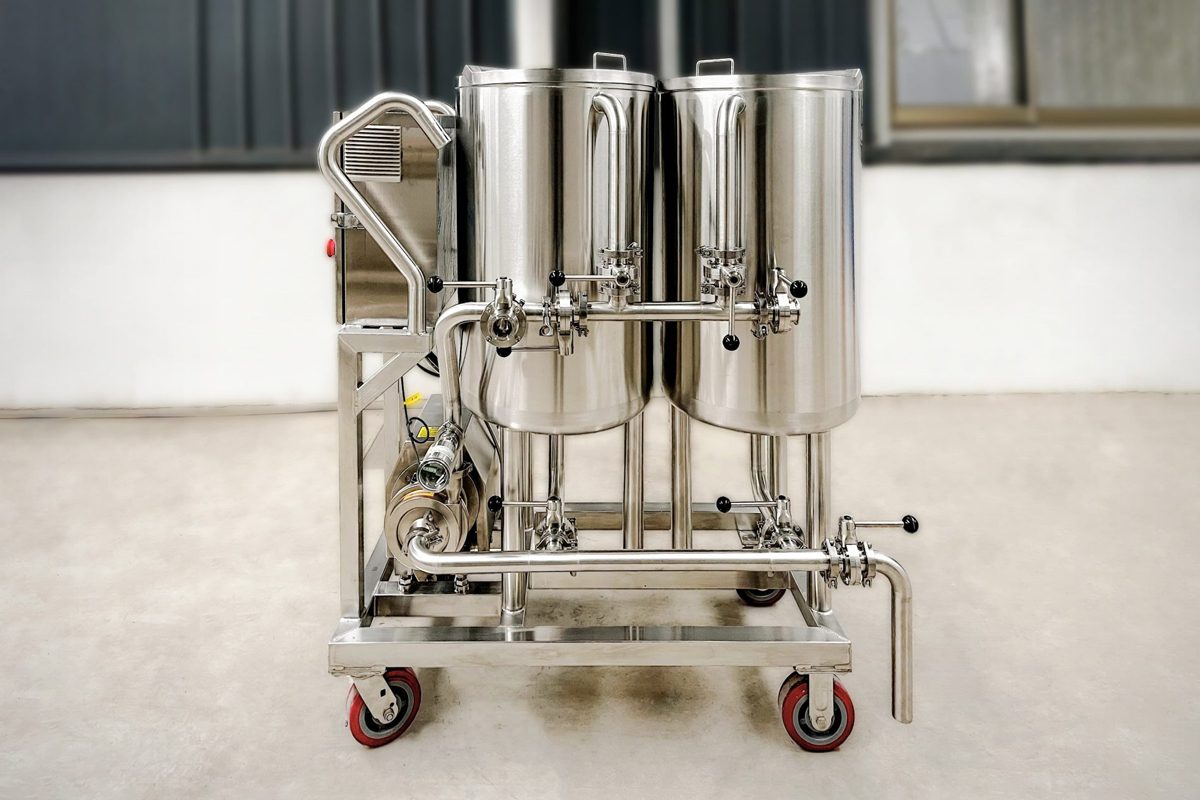
Design Principles For CIP Systems
In the winemaking industry, maintaining impeccable hygiene standards helps ensure the quality and safety of the end product. Cleaning-in-place (CIP) systems play a vital role in this process by providing an efficient and automated method for cleaning the interior surfaces of brewing equipment, including brewhouse equipment, fermentation tanks, bright tanks, and pipelines. These systems eliminate the need for manual disassembly, thereby reducing downtime and minimizing the risk of contamination. The design of an effective CIP system for breweries involves careful consideration of factors such as the types of soils typically encountered, the selection of appropriate cleaning agents, and the configuration of the system to accommodate different equipment sizes and layouts. By optimizing the cleaning process, CIP systems help breweries maintain consistent product quality, comply with regulatory standards, and improve overall operational efficiency. This article explores the fundamental design principles of CIP systems specifically tailored for the brewery environment.
Complete Guide
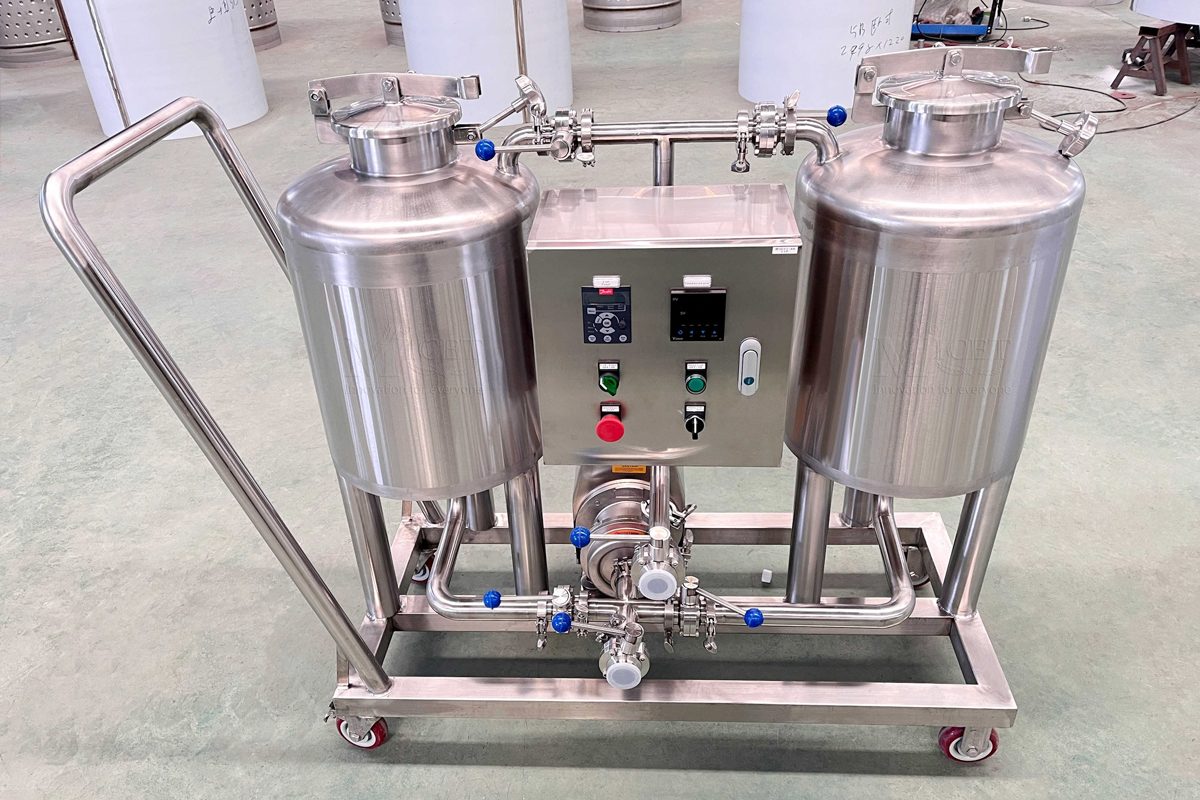
Understanding CIP Systems
Cleaning-in-place (CIP) systems keep your brewery sanitary and operating efficiently. These systems are designed to clean the interior surfaces of brewing equipment (such as brewhouse equipment, fermentation tanks, bright tanks, and pipelines) without requiring disassembly. This automatic cleaning process ensures consistent quality and safety of the beer produced.
Key Components of CIP Systems
- CIP Skid: The CIP skid is the central unit of the system, typically comprising tanks for cleaning solutions, pumps for circulating these solutions, heat exchangers for temperature control, and a control panel for system automation.
- Cleaning Solutions: CIP systems use various cleaning agents, including caustics, acids, and sanitizers, selected based on the type of soil and equipment. In breweries, these solutions help remove residues like hops, yeast, and proteins.
- Piping and Valves: A network of pipes and valves directs the cleaning solutions throughout the brewing system. The design of this network is critical for efficient and thorough cleaning.
- Control Systems: Modern CIP systems feature advanced control systems that automate the cleaning process, regulate cleaning parameters, and provide data logging for traceability.
- Sensors and Instrumentation: These include flow meters, conductivity sensors, and temperature probes, which monitor and control the cleaning process to ensure it meets specified standards.
Working Principles
CIP systems operate through a sequence of cleaning stages that include:
- Pre-Rinse: Water is flushed through the system to remove loose particles and prepare the surfaces for chemical cleaning.
- Caustic Wash: A caustic solution is circulated to break down organic matter, such as protein and yeast residues, commonly found in brewing equipment.
- Rinse: The system is rinsed with water to remove the caustic solution and dislodged soils.
- Acid Wash: An acid solution may be used to dissolve mineral deposits and beer stones that can build up on equipment surfaces.
- Final Rinse: A final water rinse removes any residual cleaning agents.
- Sanitization: A sanitizing solution is often circulated to ensure microbial control, making the system ready for the next brewing cycle.
CIP systems in breweries are designed to be flexible and efficient, accommodating different sizes and configurations of brewing equipment. They also help prevent cross-contamination between batches and reduce the risk of spoilage. By understanding the components and functioning of CIP systems, breweries can optimize their cleaning processes, ensuring that equipment is thoroughly cleaned and sanitized between production runs. This understanding also supports compliance with regulatory standards and enhances overall operational efficiency.
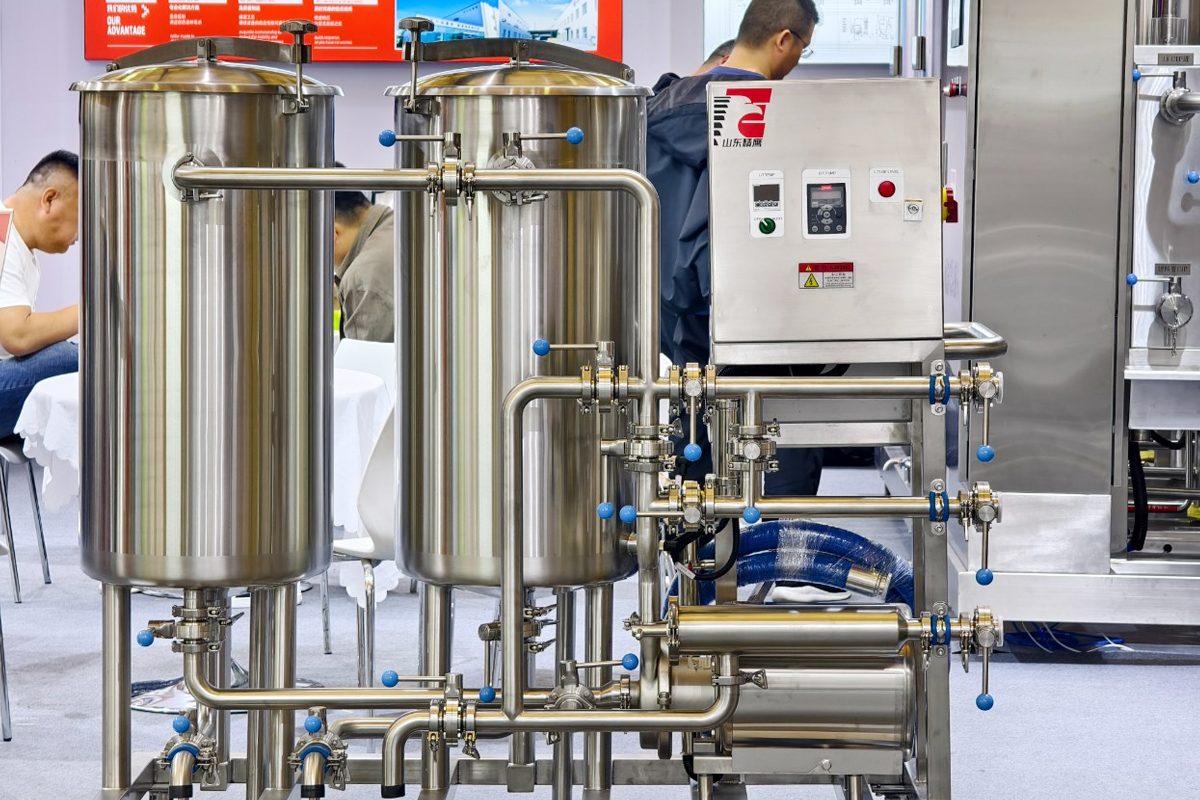
Importance of CIP Systems
Cleaning-in-place (CIP) systems provide a reliable and effective method for maintaining cleanliness and hygiene. The importance of CIP systems can be highlighted through their impact on product quality and safety, regulatory compliance, and operational efficiency.
Product Quality and Safety
One of the primary benefits of CIP systems is their ability to maintain high product quality and safety standards. In breweries, any residue left in the equipment, such as yeast, hops, or proteins, can contaminate the next batch of beer, leading to off-flavors, spoilage, or even hazardous bacterial growth. CIP systems ensure that all equipment surfaces are thoroughly cleaned and sanitized, reducing the risk of contamination and ensuring that each batch of beer is consistent in quality. This meticulous cleaning process prevents any harmful microorganisms from affecting the taste and safety of the final product.
Regulatory Compliance
The brewing industry is subject to stringent regulations regarding hygiene and sanitation. Regulatory bodies, such as the Food and Drug Administration (FDA) in the United States, set specific standards for cleanliness that breweries must adhere to. CIP systems help breweries comply with these regulations by providing a controlled and validated cleaning process. The automation and documentation capabilities of modern CIP systems allow breweries to maintain accurate records of cleaning procedures, ensuring traceability and accountability. This not only helps in meeting legal requirements but also in building trust with consumers and stakeholders.
Operational Efficiency
CIP systems significantly enhance operational efficiency by automating the cleaning process. Traditional manual cleaning methods can be labor-intensive, time-consuming, and prone to inconsistencies. In contrast, CIP systems streamline the cleaning process, reducing downtime and labor costs. The automation of cleaning cycles ensures that equipment is cleaned quickly and effectively, allowing for faster turnaround between production runs. Additionally, CIP systems are designed to use cleaning solutions efficiently, minimizing waste and reducing costs associated with chemical usage. The ability to clean equipment without disassembly also reduces the risk of equipment damage and wear, prolonging the lifespan of brewery machinery.
CIP systems are an indispensable component of modern brewing operations. They play a critical role in maintaining product quality and safety, ensuring regulatory compliance, and optimizing operational efficiency. By investing in well-designed CIP systems, breweries can protect their brand reputation, meet industry standards, and achieve cost-effective and sustainable production processes.
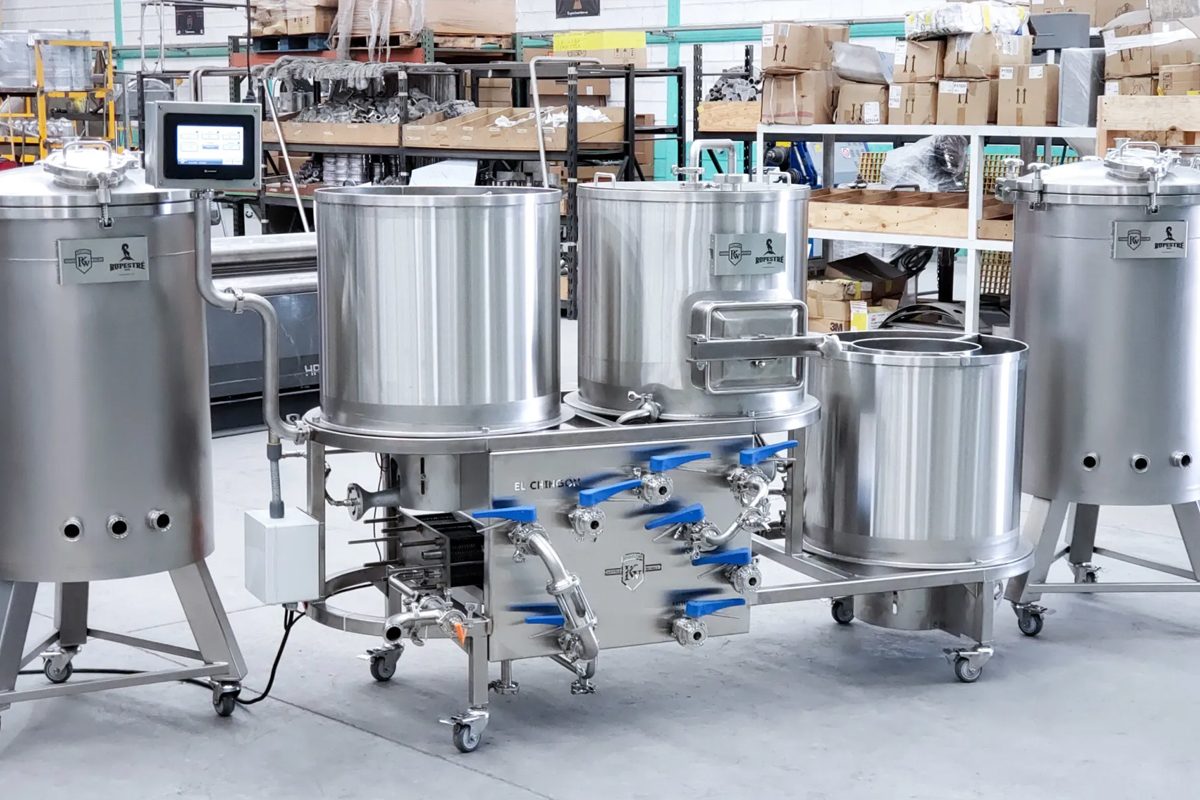
Design Principles
Designing an effective Cleaning-in-place (CIP) system requires careful consideration of various principles that ensure safety, efficiency, and compliance with industry standards. The following key design principles are crucial for developing a robust and efficient CIP system in the brewing industry:
Safety and Regulatory Compliance
Safety and regulatory compliance are paramount in the design of CIP systems. The system must be designed to prevent chemical exposure and ensure the safe handling of cleaning agents. This includes incorporating safety features such as emergency shutdown mechanisms, interlock systems, and proper ventilation to manage fumes from cleaning solutions. Additionally, the system must comply with relevant industry regulations, such as those set by the FDA or local health authorities. Compliance involves not only ensuring that cleaning procedures meet hygiene standards but also maintaining detailed records and validation protocols to demonstrate adherence to these standards.
System Integration and Automation
System integration and automation contribute to the seamless operation of the CIP system. The CIP system should be fully integrated with the brewery’s production equipment, allowing for automated cleaning cycles that can be initiated and monitored from a central control system. Automation ensures consistent cleaning, reduces human error, and allows for precise control over cleaning parameters such as time, temperature, and concentration of cleaning agents. Integration also facilitates data logging, enabling breweries to maintain comprehensive records of cleaning processes for quality control and regulatory purposes.
Fluid Dynamics and Flow Patterns
The design of CIP systems must account for fluid dynamics and flow patterns to ensure efficient and thorough cleaning. Proper flow rate and fluid velocity achieve sufficient turbulence, which helps remove dirt and residue from equipment surfaces. The system should be designed to minimize dead zones and ensure uniform distribution of cleaning solutions throughout all parts of the equipment. This includes the strategic placement of spray balls, nozzles, and other cleaning devices to cover all surfaces effectively.
Chemical Compatibility
Chemical compatibility is a vital consideration in CIP system design. The materials used in the system, including pipes, tanks, valves, and gaskets, must be compatible with the cleaning agents used. This compatibility prevents corrosion, degradation, and potential contamination of the cleaning solutions. Selecting appropriate materials, such as stainless steel or specialized plastics, ensures the longevity and reliability of the system. Additionally, the CIP system should allow for the safe and efficient handling and disposal of cleaning chemicals, adhering to environmental regulations and safety standards.
Temperature Control
Temperature control is a crucial factor in the effectiveness of CIP systems. The temperature of cleaning solutions can significantly impact their ability to dissolve and remove soils. The system should include heaters or heat exchangers to achieve and maintain the desired temperature for each cleaning cycle. It is also important to monitor and control temperature to prevent damage to sensitive equipment or materials. Proper insulation and temperature sensors help maintain consistent temperatures and improve the efficiency of the cleaning process.
Environmental Considerations
Environmental considerations are increasingly important in the design of CIP systems. Breweries are focusing on sustainability by reducing water and energy consumption and minimizing the environmental impact of cleaning processes. CIP systems should be designed to optimize the use of water and cleaning agents, including the potential for recycling and reusing cleaning solutions. Energy-efficient components, such as pumps and heat exchangers, can reduce the system’s overall energy footprint. Additionally, proper disposal of waste and cleaning chemicals must be considered to prevent environmental contamination and comply with environmental regulations.
The design principles for CIP systems in breweries encompass a range of factors, from safety and regulatory compliance to fluid dynamics and environmental sustainability. By carefully considering these principles, breweries can develop CIP systems that ensure effective cleaning, maintain high standards of hygiene and safety, and operate efficiently and sustainably.
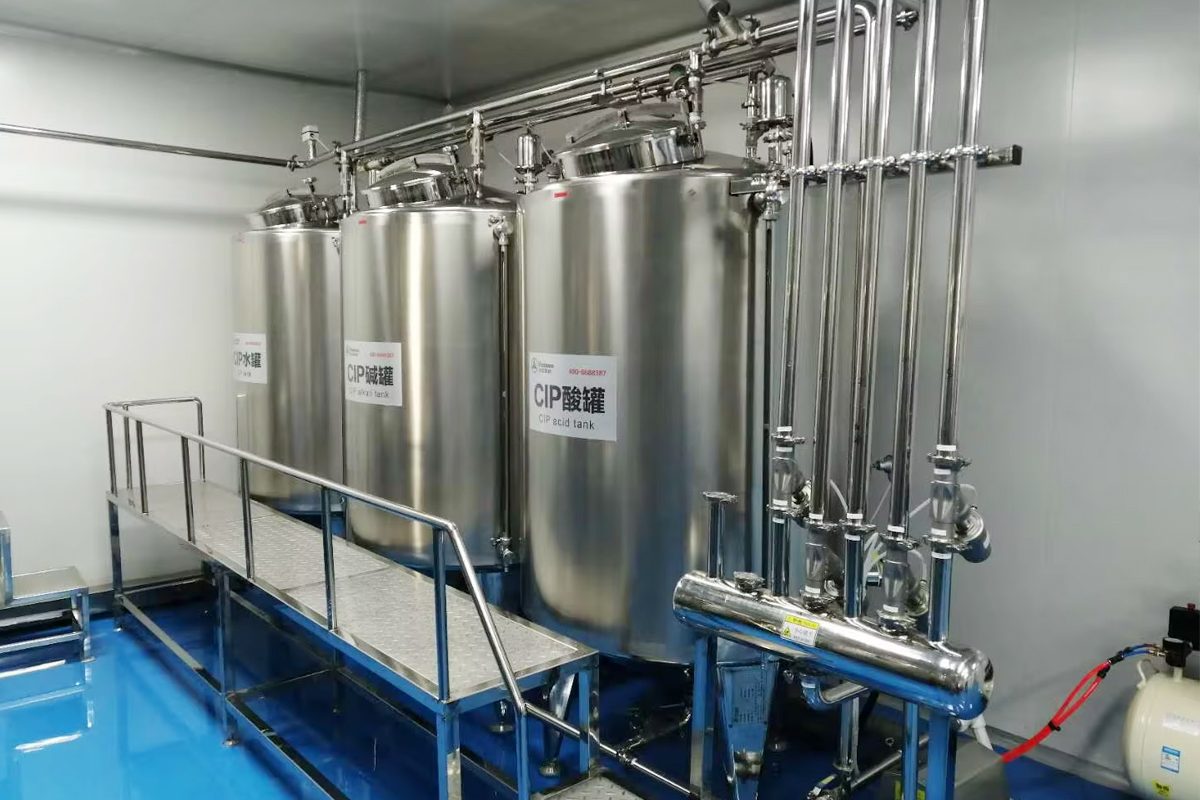
Operational Considerations
When designing and implementing a clean-in-place (CIP) system in a brewery, operational considerations can ensure the system operates efficiently. Key aspects to focus on include the establishment of cleaning protocols and cycles, ongoing monitoring and validation, and regular maintenance and upkeep.
Cleaning Protocols and Cycles
Establishing detailed cleaning procedures and cycles will help the CIP system operate consistently and efficiently. These protocols outline the specific procedures for cleaning different types of equipment, such as brewhouses, fermentation tanks, bright tanks, and pipelines. A typical cleaning cycle includes several stages: pre-rinse, caustic wash, intermediate rinse, acid wash, final rinse, and sanitization. The duration, temperature, flow rate, and concentration of cleaning agents used in each stage must be carefully defined based on the nature of the residues and the type of equipment being cleaned.
Customizing these protocols for various brewing processes and equipment ensures thorough cleaning while preventing the overuse of cleaning chemicals and water. Additionally, breweries may develop specialized cycles for dealing with specific challenges, such as removing stubborn deposits like beer stones or addressing microbial contamination. Consistent execution of these protocols helps maintain high hygiene standards and prevents cross-contamination between batches.
Monitoring and Validation
Monitoring and verification ensure that the CIP system is operating within the required parameters and meeting hygiene standards. Continuous monitoring of key variables such as temperature, flow rate, pressure, and chemical concentration maintains the effectiveness of the cleaning process. Sensors and control systems should be in place to provide real-time data, enabling operators to make adjustments as needed.
Validation involves testing and documenting that the CIP system consistently performs as required. This includes verifying that the system removes contaminants effectively and that equipment surfaces are free from residues after cleaning. Regular microbiological testing and chemical analysis may be conducted to ensure that cleaning protocols are adequate. Additionally, validation documentation provides evidence that the CIP system complies with industry standards and legal requirements.
Maintenance and Upkeep
Regular maintenance and servicing can ensure that your CIP system remains reliable and efficient. Maintenance activities should include inspecting and cleaning critical components such as pumps, valves, nozzles, and spray balls to prevent clogging and wear. It is also important to check and calibrate sensors and control systems regularly to maintain accurate monitoring and control.
Preventive maintenance schedules should be established to address potential issues before they lead to system failures or inefficiencies. This includes replacing worn or damaged parts, ensuring proper lubrication of mechanical components, and checking for leaks or corrosion in piping and tanks. Keeping detailed maintenance records helps track the system’s performance over time and plan for future upgrades or replacements.
Proper upkeep also involves managing the cleaning agents and chemicals used in the system. This includes monitoring the inventory, ensuring proper storage, and safely disposing of used chemicals. Following best practices for chemical handling and disposal not only ensures the safety of personnel but also minimizes the environmental impact of the CIP process.
Operational considerations for CIP systems encompass a comprehensive approach to managing cleaning protocols, monitoring and validation, and maintenance. By meticulously planning and executing these aspects, breweries can ensure the consistent performance of their CIP systems, maintain high standards of cleanliness and hygiene, and support efficient and sustainable operations.
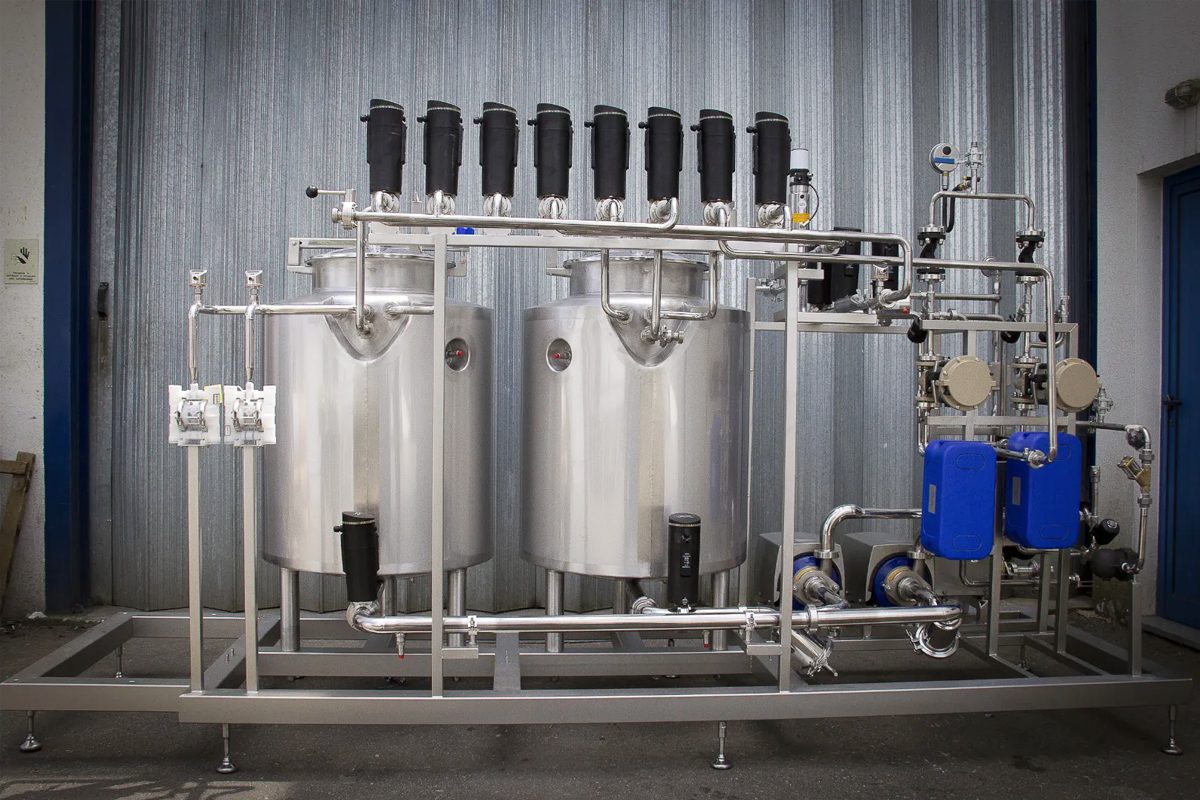
Challenges and Solutions
Designing and implementing an effective Cleaning-in-place (CIP) system involves navigating several challenges that can impact the system’s efficiency and effectiveness. Understanding these challenges and finding appropriate solutions can keep brewery cleanliness levels high and operations efficient. Key challenges include complex equipment geometries, biofilm formation, chemical compatibility, and water quality and supply.
Complex Equipment Geometries
- Challenge: Brewing equipment often includes complex geometries, such as narrow pipes, intricate valve systems, and tanks with varied shapes and sizes. These complexities can create difficult-to-clean areas, or “shadowed” zones, where cleaning solutions may not reach effectively.
- Solution: To address this challenge, careful design and optimization of the CIP system are essential. This includes the strategic placement of spray balls, nozzles, and other cleaning devices to ensure thorough coverage. Using multiple types of spray devices with varying spray patterns can help reach all surfaces. Additionally, the system should be designed to maintain adequate flow rates and turbulence, which are critical for removing residues from complex surfaces. Computational fluid dynamics (CFD) modeling can be used during the design phase to simulate cleaning processes and optimize the arrangement of cleaning devices.
Biofilm Formation
- Challenge: Biofilm formation is a significant concern in breweries, as biofilms can harbor spoilage organisms and pathogens, making them resistant to standard cleaning procedures. Once established, biofilms can be difficult to remove and can lead to contamination issues.
- Solution: Preventing and controlling biofilm formation requires a multi-faceted approach. Regular and thorough cleaning is the first line of defense. CIP systems should include effective cleaning protocols that target biofilm-prone areas, using caustic and acid washes that can disrupt and remove biofilms. It is also important to use sanitizers that are effective against biofilms. Monitoring for early signs of biofilm formation, such as pressure drops or increased microbial counts, can help in taking timely action. In cases where biofilms persist, specialized cleaning agents or physical cleaning methods, such as high-pressure cleaning or ultrasonic cleaning, may be necessary.
Chemical Compatibility
- Challenge: The materials used in brewery equipment must be compatible with the chemicals used in the CIP system. Incompatible materials can degrade over time, leading to equipment damage, potential contamination, and compromised cleaning effectiveness.
- Solution: To ensure chemical compatibility, materials for all CIP components, including tanks, piping, gaskets, and seals, need to be carefully selected. Stainless steel is commonly used for its durability and resistance to corrosion from caustic and acidic cleaning agents. Additionally, proper documentation and validation of material compatibility with all chemicals used in the cleaning process should be maintained. It is also important to regularly inspect and replace components that show signs of degradation, such as pitting or cracking.
Water Quality and Supply
- Challenge: The quality and availability of water are critical factors in the effectiveness of CIP systems. Poor water quality, such as water with high hardness or microbial content, can reduce the effectiveness of cleaning agents and lead to scaling and contamination.
- Solution: Ensuring a high-quality water supply involves several measures. Water used in CIP processes should be filtered and treated to remove impurities, such as hardness ions and microorganisms. This can involve the use of water softeners, reverse osmosis systems, or ultraviolet (UV) sterilization. Monitoring water quality regularly ensures that it meets the necessary standards for CIP use. Additionally, breweries should have reliable water supply systems to prevent interruptions during the cleaning process. In regions where water supply is a concern, water recycling and conservation measures can be implemented to reduce water usage without compromising cleaning effectiveness.
Addressing the challenges associated with CIP systems requires a thorough understanding of the brewing process and the specific needs of the equipment and facility. By implementing appropriate solutions, breweries can overcome these challenges, ensuring that their CIP systems effectively maintain cleanliness and hygiene, protect equipment integrity, and support sustainable operations.
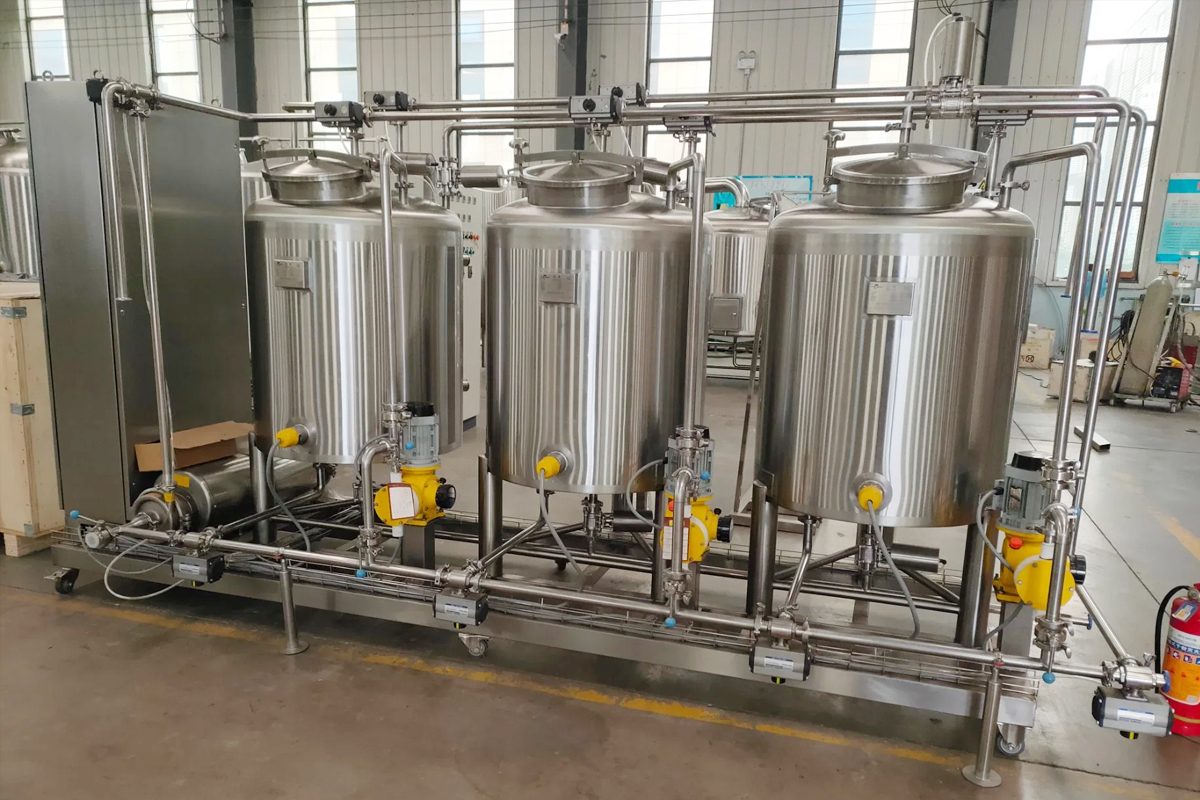
Best Practices for CIP System Design
Designing an effective Cleaning-in-place (CIP) system requires adherence to best practices that ensure the system meets the unique needs of the brewery while maintaining high standards of hygiene and operational efficiency. Key best practices include customization and flexibility, collaboration with stakeholders, emphasizing hygiene by design, and ensuring comprehensive training and documentation.
Customization and Flexibility
Each brewery has specific cleaning requirements based on the types of equipment, production processes, and the nature of the products being brewed. Customizing your CIP system to meet these unique needs can help achieve optimal performance. Flexible system design allows for adjustments to cleaning protocols and parameters as production needs change or as new equipment is introduced. This may involve designing modular systems that can be easily scaled or reconfigured, as well as incorporating adjustable settings for flow rates, temperatures, and cleaning solution concentrations. Customization ensures that the CIP system can handle a variety of cleaning tasks efficiently, from small fermentation tanks to large storage tanks, and can adapt to future growth and technological advancements.
Collaboration with Stakeholders
Designing a successful CIP system involves collaboration with a range of stakeholders, including brewery management, production staff, equipment suppliers, and CIP system manufacturers. Engaging these stakeholders early in the design process helps ensure that all requirements and constraints are considered. Production staff can provide valuable insights into the practical aspects of equipment usage and cleaning needs, while equipment suppliers can offer guidance on compatibility and integration. Working closely with CIP system manufacturers ensures that the design incorporates the latest technologies and best practices. Regular communication and feedback loops during the design and implementation phases help address any issues promptly and ensure that the system meets the operational goals of the brewery.
Emphasizing Hygiene by Design
The design of the CIP system should prioritize hygiene to prevent contamination and ensure product safety. This involves selecting materials that are easy to clean and resistant to corrosion, such as stainless steel, and designing equipment with smooth surfaces and minimal crevices where residues can accumulate. The layout of the system should minimize dead legs and other areas where cleaning solutions might not circulate effectively. Incorporating hygienic design principles, such as proper drainage and avoiding horizontal surfaces where water can pool, helps maintain a sanitary environment. Regular validation and verification of the cleaning process, including microbiological testing, ensure that hygiene standards are consistently met.
Training and Documentation
Comprehensive training and documentation can assist in the effective operation of a CIP system. All personnel involved in the operation, maintenance, and monitoring of the CIP system should receive thorough training on the system’s components, cleaning protocols, safety procedures, and troubleshooting techniques. Training should be ongoing to keep staff updated on any changes or upgrades to the system. Detailed documentation, including standard operating procedures (SOPs), maintenance schedules, and validation records, provides a reference for staff and ensures consistency in the cleaning process. Proper documentation also supports regulatory compliance and facilitates audits and inspections.
Adhering to best practices in CIP system design helps breweries achieve efficient and effective cleaning processes that support product quality and safety. Customization and flexibility ensure that the system meets specific operational needs, while collaboration with stakeholders enhances the design process. Emphasizing hygiene in design and providing comprehensive training and documentation can help maintain high standards of cleanliness and operational efficiency. By following these best practices, breweries can optimize their CIP systems and support sustainable, high-quality production.
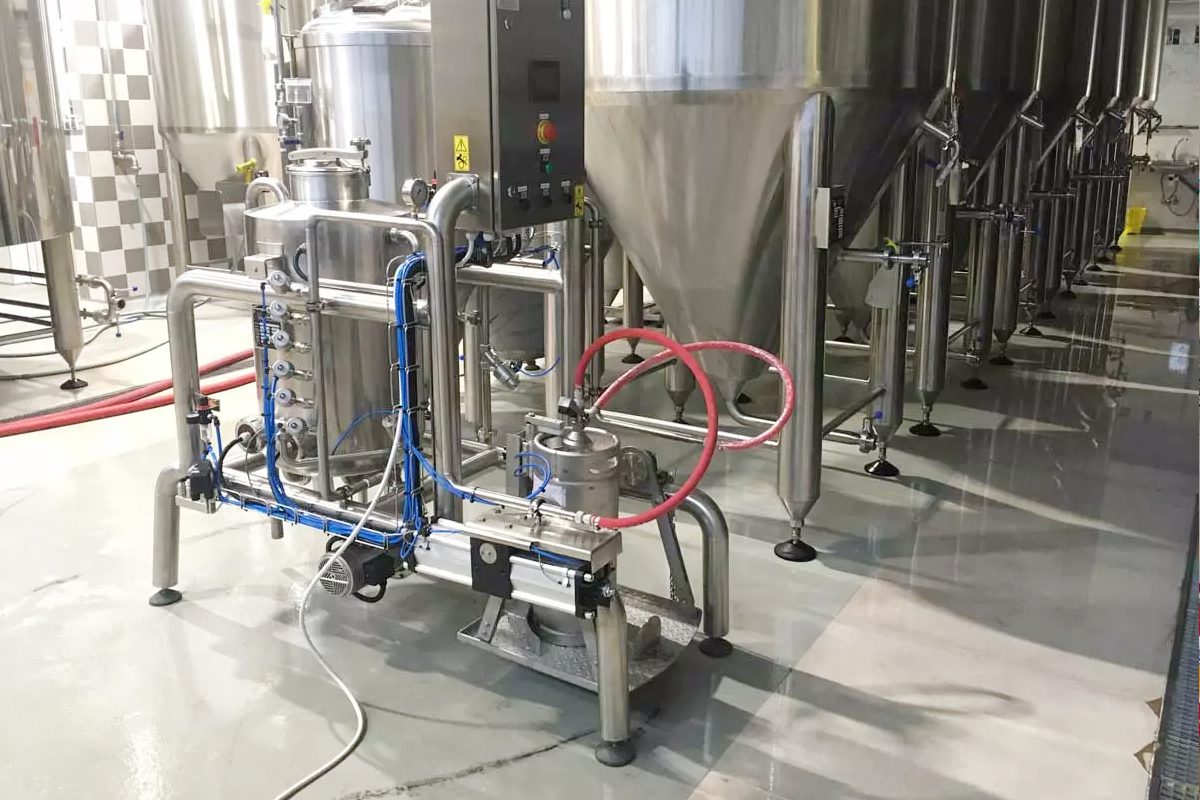
Summary
Designing an effectively clean-in-place (CIP) system maintains high sanitation standards, product quality, and operational efficiency in your brewery. Key design principles include ensuring safety and regulatory compliance, integrating advanced automation and control systems, and optimizing fluid dynamics and flow patterns for thorough cleaning. The system must be tailored to the specific needs of the brewery, with careful consideration of chemical compatibility, temperature control, and environmental sustainability. Addressing challenges such as complex equipment geometry, biofilm formation, and water quality can enable effective cleaning. Best practices involve customization and flexibility, collaboration with stakeholders, emphasizing hygiene by design, and providing comprehensive training and documentation. By following these principles and practices, breweries can develop CIP systems that are not only efficient and reliable but also adaptable to evolving industry standards and technological advancements, ensuring consistent and safe production processes.
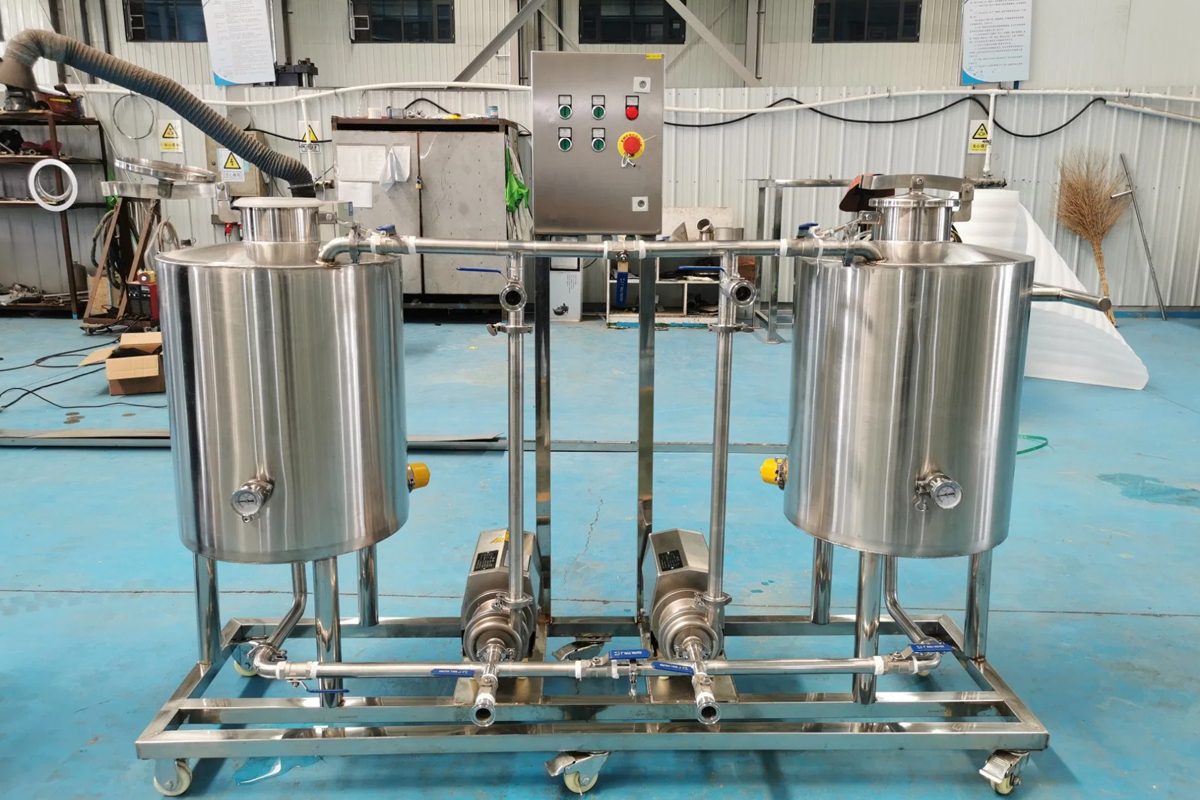
Get A Turnkey Brewery Solution
At ZYB Craft, we specialize in providing comprehensive turnkey brewery solutions, including expertly designed CIP systems that cater to the unique needs of your brewery. Our solutions encompass the entire brewing process, from initial planning and equipment selection to installation, training, and ongoing support. We understand that each brewery has specific requirements, so we customize our CIP systems to ensure optimal cleaning efficiency and compliance with industry standards. Our team of experienced engineers and brewing professionals collaborates closely with you to design and implement a CIP system that integrates seamlessly with your existing setup, enhancing both product quality and operational efficiency. With ZYB Craft, you can trust that every aspect of your brewery’s cleaning and sanitization needs is meticulously handled, allowing you to focus on crafting exceptional brews. Partner with us for a reliable, efficient, and fully integrated brewery solution that supports your growth and success.



